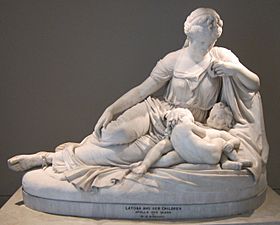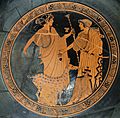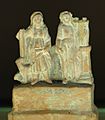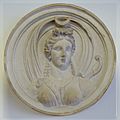Artemis facts for kids
Quick facts for kids Artemis |
|
|---|---|
| Goddess of nature, childbirth, wildlife, the Moon, the hunt, sudden death, animals, young women, and archery | |
| Member of the Twelve Olympians | |
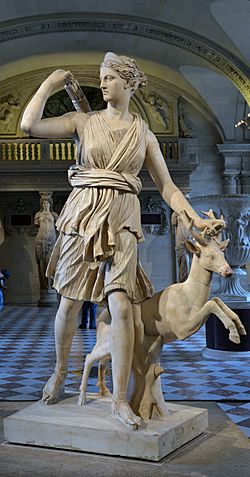
|
|
| Abode | Mount Olympus |
| Planet | Moon |
| Animals | deer, serpent, dog, boar, goat, bear, quail, buzzard, guineafowl |
| Symbol | bow and arrows, crescent moon, animal pelts, spear, knives, torch, lyre, amaranth |
| Tree | cypress, palm, walnut |
| Mount | A golden chariot driven by four golden-horned deer |
| Personal information | |
| Born | Island of Delos, Greece |
| Parents | Zeus and Leto |
| Siblings | Apollo (twin), Aeacus, Angelos, Aphrodite, Ares, Athena, Dionysus, Eileithyia, Enyo, Eris, Ersa, Hebe, Helen of Troy, Hephaestus, Heracles, Hermes, Minos, Pandia, Persephone, Perseus, Rhadamanthus, the Graces, the Horae, the Litae, the Muses, the Moirai |
| Equivalents | |
| Roman equivalent | Diana |
| Etruscan equivalent | Artume |
| Canaanite equivalent | Kotharat |
| Egyptian equivalent | Bastet |
| Zoroastrian equivalent | Drvaspa |
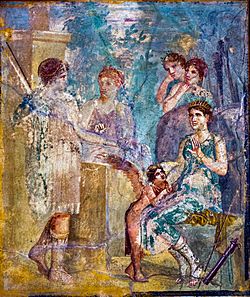
Artemis is a goddess in Greek mythology. She is one of the Twelve Olympians. She is the daughter of Zeus and Leto. She is the twin sister of Apollo.
Artemis is the goddess of hunting, wild animals and the wilderness.
When Artemis was born she became known as the goddess of the moon.
Artemis was one of the most widely venerated of the Ancient Greek deities, her worship spread throughout ancient Greece, with her multiple temples, altars, shrines, and local veneration found everywhere in the ancient world. Her great temple at Ephesus was one of the Seven Wonders of the Ancient World, before it was burnt to the ground. Artemis' symbols included a bow and arrow, a quiver, and hunting knives, and the deer and the cypress were sacred to her. Diana, her Roman equivalent, was especially worshipped on the Aventine Hill in Rome, near Lake Nemi in the Alban Hills, and in Campania.
Contents
Etymology
Ancient Greek writers, by way of folk etymology, and some modern scholars, have linked Artemis (Doric Artamis) to ἄρταμος, artamos, i.e. "butcher" or, like Plato did in Cratylus, to ἀρτεμής, artemḗs, i.e. "safe", "unharmed", "uninjured", "pure", "the stainless maiden".
Description

Artemis is presented as a goddess who delights in hunting and punishes harshly those who cross her. She would often roam the forests of Greece, attended by nymphs and hunters. Artemis' wrath is proverbial, and represents the hostility of wild nature to humans. Homer calls Artemis πότνια θηρῶν, "the mistress of animals", a titled associated with representations in art going back as far as the Bronze Age, showing a woman between a pair of animals.
Ancient poets note Artemis' height and imposing stature, as she stands taller and more impressive than all the nymphs accompanying her. In Athens and Tegea, she was worshipped as Artemis Calliste, "the most beautiful". She was generally represented as healthy, strong, and active, bearing quiver and bow and accompanied by a dog.
Birth
Various conflicting accounts are given in Greek mythology regarding the birth of Artemis and Apollo, her twin brother. However, in terms of parentage, all accounts agree that she was the daughter of Zeus and Leto and that she was the twin sister of Apollo. In some sources, she is born at the same time as Apollo, in others, earlier or later.
Actaeon
Multiple versions of the Actaeon myth survive, though many are fragmentary. The details vary but at the core, they involve the great hunter Actaeon whom Artemis turns into a stag for a transgression, and who is then killed by hunting dogs.
According to the Latin version of the story told by the Roman Ovid, Actaeon was a hunter who, after returning home from a long day's hunting in the woods, stumbled upon Artemis and her retinue of nymphs bathing in her sacred grotto. Artemis is said to splash some water on Actaeon, and he was immediately transformed into a deer. In panic he ran away. But he did not go far, as he was hunted down and eventually caught by his own fifty hunting dogs, who could not recognize their own master.
Orion
Orion was Artemis' hunting companion. A great hunter himself, he bragged that he would kill every beast on earth. Gaia, the earth, was not too pleased to hear that, and sent a giant scorpion to sting him. Artemis then transferred him into the stars as the constellation Orion.
Istrus wrote a version in which Artemis fell in love with Orion, apparently the only person she ever did. She meant to marry him, and no talk from her brother Apollo would change her mind. Apollo then decided to trick Artemis, and while Orion was off swimming in the sea, he pointed at him (barely a spot in the horizon) and wagered that Artemis could not hit that small "dot". Artemis, ever eager to prove she was the better archer, shot Orion, killing him. She then placed him among the stars.
Trojan War
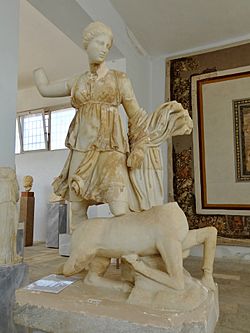
Artemis may have been represented as a supporter of Troy because her brother Apollo was the patron god of the city, and she herself was widely worshipped in western Anatolia in historical times. Artemis plays a significant role in the war; like Leto and Apollo, Artemis took the side of the Trojans. At the beginning of the Greek's journey to Troy, Artemis punished Agamemnon after he killed a sacred stag in a sacred grove and boasted that he was a better hunter than the goddess.
When the Greek fleet was preparing at Aulis to depart for Troy to commence the Trojan War, Artemis becalmed the winds. The seer Calchas erroneously advised Agamemnon that the only way to appease Artemis was to sacrifice his daughter Iphigenia. In some version of the myth, Artemis then snatched Iphigenia from the altar and substituted a deer; in others, Artemis allowed Iphigenia to be sacrificed.
Worship
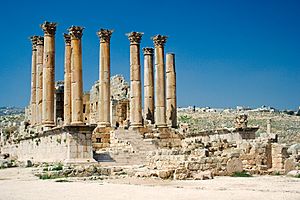
Artemis, the goddess of forests and hills, was worshipped throughout ancient Greece. Her best known cults were on the island of Delos (her birthplace), in Attica at Brauron and Mounikhia (near Piraeus), and in Sparta. She was often depicted in paintings and statues in a forest setting, carrying a bow and arrows and accompanied by a deer.
The ancient Spartans used to sacrifice to her as one of their patron goddesses before starting a new military campaign.
Athenian festivals in honor of Artemis included Elaphebolia, Mounikhia, Kharisteria, and Brauronia. The festival of Artemis Orthia was observed in Sparta.
In art
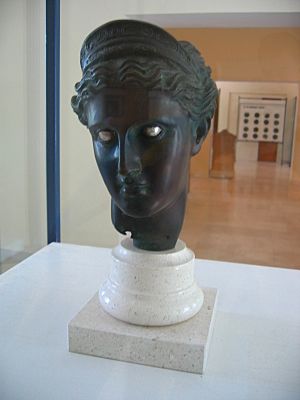
In Greek classical art she is usually portrayed as a maiden huntress, young, tall, and slim, clothed in a girl's short skirt, with hunting boots, a quiver, a golden or silver bow and arrows. Often, she is shown in the shooting pose, and is accompanied by a hunting dog or stag. When portrayed as a lunar deity, Artemis wore a long robe and sometimes a veil covered her head.
Legacy
In astronomy
- 105 Artemis (an asteroid discovered in 1868)
- Artemis (crater) (a tiny crater on the moon, named in 2010)
- Artemis Chasma (a nearly circular fracture on the surface of the planet Venus, described in 1980)
- Artemis Corona (an oval feature largely enclosed by the Artemis Chasma, also described in 1980)
- Acronym (ArTeMiS) for "Architectures de bolometres pour des Telescopes a grand champ de vue dans le domaine sub-Millimetrique au Sol", a large bolometer camera in the submillimeter range that was installed in 2010 at the Atacama Pathfinder Experiment (APEX), located in the Atacama Desert in northern Chile.
In taxonomy
The taxonomic genus Artemia, which entirely comprises the family Artemiidae, derives from Artemis. Artemia are aquatic crustaceans known as brine shrimp, the best-known species of which, Artemia salina, or Sea Monkeys, was first described by Carl Linnaeus in his Systema Naturae in 1758. Artemia live in salt lakes, and although they are almost never found in an open sea, they do appear along the Aegean coast near Ephesus, where the Temple of Artemis once stood.
In modern spaceflight
The Artemis program is an ongoing robotic and crewed spaceflight program carried out by NASA, U.S. commercial spaceflight companies, and international partners such as ESA, the Japan Aerospace Exploration Agency, and the Canadian Space Agency. The program has the goal of landing "the first woman and the next man" on the lunar south pole region no earlier than 2025.
Related pages
- Artume - Etruscan mythology version of Artemis.
- Diana - Roman mythology version of Artemis.
- Temple of Artemis
Images for kids
-
Apollo (left) and Artemis (right). Brygos (potter, signed), Briseis Painter, Tondo of an Attic red-figure cup, ca. 470 BCE, Louvre.
-
Roman marble Bust of Artemis after Kephisodotos (Musei Capitolini), Rome.
-
Hairnet with the relief bust of Artemis with a quiver. Gold, 3rd century BC, National Archaeological Museum of Athens, Greece.
-
Artemis of the Rospigliosi type. Marble, Roman copy of the 1st–2nd centuries CE after a Hellenistic original, Louvre.
-
The Death of Adonis, by Giuseppe Mazzuoli, 1709. Hermitage Museum, Saint Petersburg, Russia.
-
Artemis with a crescent moon and billowing cloak, sandstone medallion from the Arbeithaus in Bremen, 1830.
-
The site of the Temple of Artemis at Ephesus. Its final form was one of the Seven Wonders of the Ancient World.
-
Silver tetradrachm of the Indo-Greek king Artemidoros (whose name means "gift of Artemis"), c. 85 BCE, featuring Artemis with a drawn bow and a quiver on her back on the reverse of the coin
See also
 In Spanish: Artemisa para niños
In Spanish: Artemisa para niños


